
The Second Boer War, also known as the Boer War, Anglo–Boer War, or South African War, was a conflict fought between the British Empire and the two Boer republics over the Empire's influence in Southern Africa.

The South West Africa campaign was the conquest and occupation of German South West Africa by forces from the Union of South Africa acting on behalf of the British imperial government at the beginning of the First World War.
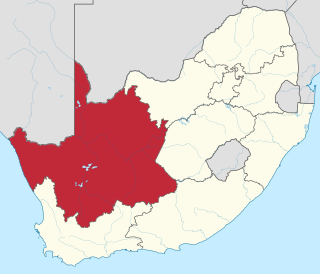
The Northern Cape is the largest and most sparsely populated province of South Africa. It was created in 1994 when the Cape Province was split up. Its capital is Kimberley. It includes the Kalahari Gemsbok National Park, part of the Kgalagadi Transfrontier Park and an international park shared with Botswana. It also includes the Augrabies Falls and the diamond mining regions in Kimberley and Alexander Bay.

Upington is a town founded in 1873 and located in the Northern Cape province of South Africa, on the banks of the Orange River. The town was originally called Olijvenhoutsdrift, due to the abundance of olive wood trees in the area, but later renamed after Sir Thomas Upington, Attorney-General and then Prime Minister of the Cape. It originated as a mission station established in 1871 and run by Reverend Christiaan Schröder. The mission station now houses the Kalahari Orange Museum. The museum is also the home of a donkey statue, which recognises the enormous contribution that this animal made to the development of the region during the pioneering days of the 19th century.
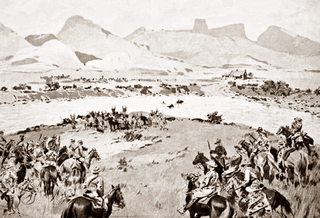
The Maritz rebellion, also known as the Boer revolt, Third Boer War, or the Five Shilling rebellion, was an armed insurrection in South Africa in 1914, at the start of World War I. It was led by Boers who supported the re-establishment of the South African Republic in the Transvaal. Many members of the South African government were themselves Boers who had fought with the Maritz rebels against the British in the Second Boer War, which had ended twelve years earlier. The rebellion failed, and its ringleaders received heavy fines and terms of imprisonment. One of them, Jopie Fourie, was executed.
The R359 is a regional route in the Northern Cape province of South Africa that runs along the south bank of the Orange River from Augrabies Falls through Augrabies and Kakamas to Upington.

The Battle of Modder River was an engagement in the Boer War, fought at Modder River, on 28 November 1899. A British column under Lord Methuen, that was attempting to relieve the besieged town of Kimberley, forced Boers under General Piet Cronjé to retreat to Magersfontein, but suffered heavy casualties altogether.
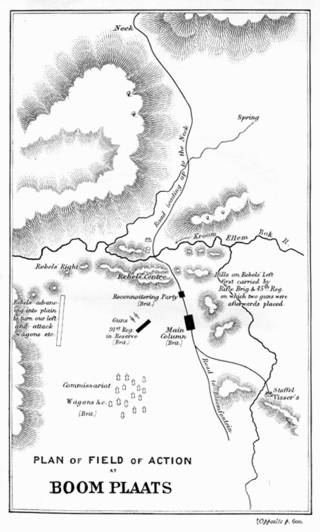
The Battle of Boomplaats was fought near Jagersfontein at 29°50′53.47″S25°38′56.54″E on 29 August 1848 between the British and the Voortrekkers. The British were led by Sir Harry Smith, while the Boers were led by Andries Pretorius. The British were victorious after one Boer opened fire too early and betrayed their position.

The Nelson Mandela Artillery Regiment is a reserve artillery regiment of the South African Army and part of the South African Army Artillery Formation.
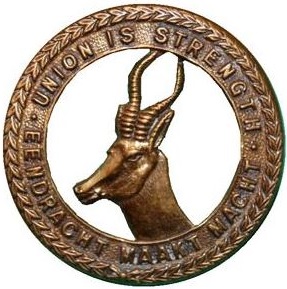
The South African Overseas Expeditionary Force (SAOEF) was a volunteer military organisation in World War I.
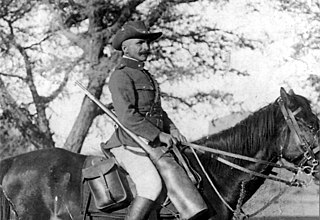
The Battle of Sandfontein was fought between the Union of South Africa on behalf of the British Imperial Government and the German Empire on 26 September 1914 at Sandfontein, during the first stage of the South West Africa Campaign of World War I, and ended in a German victory.

Kakamas is a town founded in 1898 and located in the Northern Cape province of South Africa, on the banks of the Orange River.

The South African Wars, including but also known as the Confederation Wars, were a series of wars that occurred in the southern portion of the African continent between 1879 and 1915. Ethnic, political, and social tensions between European colonial powers and indigenous Africans led to increasing hostilities, culminating in a series of wars and revolts, which had lasting repercussions on the entire region. A key factor behind the growth of these tensions was the pursuit of commerce and resources, both by countries and individuals, especially following the discoveries of diamonds in the region in 1867 and gold in 1862.

Kenhardt is a small town in the Northern Cape province of South Africa. This little town is about 120 km from Upington, the largest town in the area.

The Natal Light Horse was an irregular South African Armed Forces regiment formed by Colonel John Robinson Royston in August 1914 during the First World War after petitioning General Jan Smuts for special permission to do so. Opening recruiting officers in Pietermaritzburg and Durban, a full roster of six hundred men was recruited within ten days. All of those enlisted had seen previous military service, including several Australians who had served under Royston during the Second Boer War and opted to remain in South Africa at the end of that conflict.

Keimoes is a town in the Northern Cape province of South Africa. It lies on the Orange River and is about halfway between Upington and Kakamas.
Ramansdrift is an abandoned town on the banks of the Orange River in the ǁKaras Region of Namibia. The nearest towns are Vredendal (28.8 km), Gaobis (28.8 km), Silwerstroom (32.6 km), and Hakiesdoorn (48.3 km).
Andries Gerhardus de Wet was a South African soldier and founder of the Vrykorps in German South West Africa which tried to overthrow the British-aligned government of the Union of South Africa to establish German rule.
South Africa's participation in the First World War occurred automatically when the British Government declared war on Germany in August 1914. Due to her status as a Dominion within the British Empire, South Africa, whilst having significant levels of self-autonomy, did not have the legal power to exercise an independent foreign policy and was tied to the British declaration.

Barend Daniël Bouwer was a South African general in the Boer War (1899-1902) and the First World War (1914-1918).
















